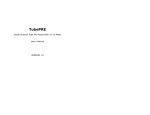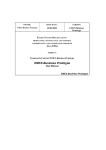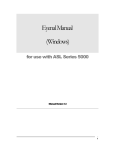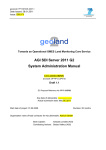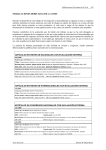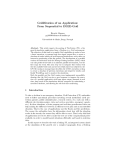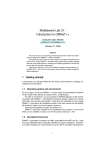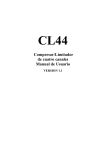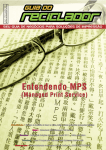Download Household Control System Software Requirements Specification
Transcript
Household Control System Software Requirements Specification Version 1.0 Christoforos Miliotis Vytautas Kaucleris Yikang Mao Zhendong Fu Huike Shen Xiao He 1 Table of contents 1. Introduction…………………………………………………………………………………………….3 1.1Purpose………………………………………………………………………………………………..3 1.1.1 High-Level Goals………………………………………………………………….....3 1.2 The Client & other Stakeholders……………………………………………………3 1.3 Users of the product………………………………………………………………………3 2. Overall Description…………………………………………………………………………………4 2.1 Mandated Constraints……………………………………………………………………….4 2.1.1 Solution Constraints…………………………………………………………….4 2.1.2 Implementation environment of the current system………….4 2.1.3 Partner or collaborative applications……..………………………….4 2.1.4 Anticipated Workplace Environment………………………………….4 2.1.5 Schedule Constraints…………………………………………………………..4 2.1.6 Budget Constraints………………………………………………………………4 2.2 Naming conventions & definitions………………………………………………..5 2.3 Relevant facts & assumptions……………………………………………………….5 2.4 Product description……………………………………………………………………….5 3. Specific requirements…………………………………………………………………………….6 3.1 The scope of the product…………………………………………………………….6 3.2 Functional & Data Requirements……………………………………………….9 3.2.1 Automated Shopping…………………………………………………………9 3.2.2 ‘Follow me’ Lights & Music.……………………………………………13 3.2.3 Reminder…………………….………………………………………………….17 3.2.4 Emergency Response..…………………………………………………..20 4. Nonfunctional Requirements……………………………………………………………….24 4.1 Look & Feel Requirements……………………………………………………….24 4.2 Usability & Humanity Requirements………………………………………..24 4.3 Performance Requirements……………………………………………………..24 4.4 Operational & Environmental Requirements…………………………..25 4.5 Maintainability & Support Requirements………………………………….25 4.6 Security Requirements………………………………………………………………26 4.7 Cultural & Political Requirements…………………………………………….26 4.8 Legal Requirements………………………………………………………………….26 5. Project Issues…………………………………………………………………………………………27 5.1 Open Issues………………………………………………………………………………27 5.2 Off-The-Shelf Solutions……………………………………………………………27 5.3 New Problems………………………………………………………………………….27 5.4 Tasks…………………………………………………………………………………………27 5.5 Migration to the New Product………………………………………………….27 5.6 Risks………………………………………………………………………………………….27 5.7 Costs…………………………………………………………………………………………27 5.8 User Documentation & Training……………………………………………..27 5.9 Waiting Room…………………………………………………………………………..27 5.10 Ideas for Solutions………………………………………………………………….27 2 1. Introduction 1.1 Purpose The purpose of the Household Control System is to make the life inside the house easy & comfortable. This will be accomplished by automating some of the residents’ every-day activities inside the household. The customer has identified a niche market and wishes to enter it dynamically by selling the to-be-developed system. 1.1.1 High-Level Goals The system is intended: • To support independent living Advantage: To ease the every-day life of –mainly- impaired & elderly people • To help working people save time by automating shopping Advantage: To enable working people to devote their valuable time in other liabilities Measurement: Working people shall save 15% of the time they used to spent on going shopping • To preserve human life & property Advantage: To provide reliable cover in case of an emergency, such as accident, fire, burglary. 1.2 The Client & other Stakeholders The client of the product is a company that specializes in selling automation products in the automation & controls market. Other stakeholders may be (using prioritization): Impaired ability users Supermarket Emergency Services (fire, police, nursing) Hardware Specialists Property Developers Installation & maintenance engineers Software developers Competitors 1.3 Users of the product The people living in the house are the users of the system. Those people can be of all ages, from children to elderly people. A special category is the impaired people. The users have some specific needs & desires. It is not necessary to be able to handle a software oriented product, maybe not even a computer. Thus, there is a good chance that they are not previously exposed to the technology solution we will build. 3 2. Overall Description 2.1 Mandated Constraints 2.1.1 Solution Constraints The system should be modular so that people can buy the pieces that suit their needs The system’s standard functionality is the automated shopping 2.1.2 Implementation environment of the current system The product should be able to communicate with different types of hardware installed in the house, like sensors, touch screens, barcode readers The Hardware will be provided by the client & is not yet specified 2.1.3 Partner or Collaborative applications Our system must be able to communicate with the supermarket’s system & other services like the police, nursing or fire brigade. Investigation should be made to identify their technology-in-use. 2.1.4 Anticipated Workplace Environment It is possible that some visits will be required to the hardware suppliers, because it may be essential to understand their technology in order for the integration of software & hardware to be successful. 2.1.5 Schedule Constraints Although no time schedule has been defined by the customer, this is subject to change. 2.1.6 Budget Constraints Although no budget constraint has been defined by the customer, the nature of the system being life-preserving will raise the total cost. The customer is fully aware of this constraint. 4 2.2 Naming conventions & definitions The Household Control System will be named HCS from that point until the end of the document. Each scenario has a standard format, [SCxx], where SC is scenario & xx is the number of the scenario. For example, [SC02] is scenario 2. 2.3 Relevant Facts & Assumptions • • • • • • The system will be delivered supporting only the English language. The user will be able to control the system only when he is inside the house. The only access the user will have to the system will be from the touch screen or the remote control. Access from a computer was not specified by the client. The client is responsible for opening an account with the supermarket. The system should be able to use this account for automated shopping. Customization will be handled by the client. The system must be built supporting all functionalities. The client is responsible to gain licenses for the security & health services. The system must be able to communicate with these services’ systems. The above assumptions may change from time to time and should not be taken as granted. 2.4 Product Description The HCS is software capable of implementing the automated house. The core functionality of the system is the automation of shopping. The system suggests a shopping list and allows the user to place his order automatically. Other functionalities are the ‘follow me’ lights & music, the ‘reminder’ and the emergency responses. The ‘follow me’ lights & music means that whenever the user leaves a room, the lights & music will turn off from this particular room and will turn on again when the user will enter another room. The ‘reminder’ is a typical reminder subsystem, it allows the user to place reminders and when the event is reached, the user gets informed. Finally, the emergency responses involve the system to contact automatically the relevant agency in case of emergency. For example, if there is a fire in the house, the system will automatically inform the local fire brigade of the incident. 5 3. Specific Requirements 3.1 The scope of the product This section specifies the scope of the product. Using context & use case diagrams and scenarios will help understand the scope of the product. HCS context diagram: Use case diagram: 6 Scenarios: [SC01] Send Alert to NHS This use case defines the process of the NHS notification in case of an emergency. Preconditions The user has the emergency functionality enabled 7 Postconditions The NHS receives notification of the emergency Main success scenario 1. The user presses the button in the necklace 2. The necklace sensor sends a signal 3. The signal is transferred to the HCS by relevant hardware 4. The HCS generates a message & sends it to NHS [SC02] Send Alert to Fire Brigade This use case defines the process of the Fire Brigade notification in case of a fire in the house Preconditions The user has the emergency functionality enabled The user has set up a smoke level in each room Postconditions The Fire Brigade receives notification of the fire Main success scenario 1. The smoke level in a room is above the allowed limit 2. The smoke sensor sends a signal 3. The signal is transferred to the HCS by relevant hardware 4. The HCS generates a message & sends it to the Fire Brigade [SC03] Send Alert to the Police This use case defines the process of the Police notification in case of a burglary Preconditions The user has the emergency functionality enabled The user has enabled the alarm mode when in the house or away The door or the windows are opened Postconditions The Police receive notification of the emergency Main success scenario 1. The main door sensor, or the window sensors, detect the opening of the main door/windows 2. The appropriate sensor sends a signal 3. The signal is transferred to the HCS by the relevant hardware 4. The HCS generates a message & sends it to the Police [SC04] The user makes an order This use case defines the process when the user wishes to make his shopping from the house Preconditions All desired items are available in the quantities specified by the user Postconditions The order is delivered to the supermarket Main success scenario 1. The user selects the shopping functionality from touch screen 2. A connection with the supermarket system is established 8 3. The HCS shows the user a proposed list of products 4. The user selects the products & their quantities from the list 5. The user sends the order [SC05] The user sets the reminder This use case defines the process when the user wants to get notified for something that has to do later. Preconditions The user has the reminder functionality enabled Postconditions The user gets notified by the reminder Main success scenario 1. The user starts the reminder application using the touch screen 2. The user enter the details, like the date & time of the reminder and a note containing notification information 3. The user saves the entry 4. The reminder starts to beep when the date & time specified are reached [SC06] ‘Follow me’ lights & music This use case defines the process of the lights & music turning on & off, depending on which room the user is Preconditions The user has the ‘follow me’ functionality enabled The user has adjusted the brightness of lights The user has selected the music tracks The rooms have the appropriate infrastructure, i.e. light bulbs & speakers Postconditions The lights & music turn on & off according to which room the user is Main success scenario 1. The user leaves a room 2. The door sensor detects the movement out 3. The door sensor sends a signal 4. The signal is transferred to the HCS by the relevant hardware 5. The HCS sends a signal using the appropriate hardware to the light & the speakers sensors to turn off 6. The user enters a room 7. The door sensor detects the movement in 8. The door sensor sends a signal 9. The signal is transferred to the HCS by the relevant hardware 10. The HCS sends a signal using the appropriate hardware to the light & the speakers sensors to turn on 9 3.2 Functional & Data Requirements 3.2.1 Automated Shopping Goals: Open Shopping Function Manually Requirement 101 Requirement 9 Event/User 1 # Type Case Description: HCS should provide an option on the interface to allow users open the Shopping Function. Rationale: Users can activate this function manually. Originator: the 3rd group Fit Criterion: The shopping interface must be easy to read and use. Customer 5 Customer 2 Satisfaction Dissatisfaction Priority 5 Conflict None Supporting Materials: None History : Created 29/Nov/2007 Open Shopping Function By Scanning the Barcode Requirement 102 Requirement 9 Event/User 1 # Type Case Description: HCS should open the Shopping Function when users scan a product barcode. 10 Rationale: Users can activate this function by scanning the barcode on a product. Originator: the 3rd group Fit Criterion: The shopping interface must be easy to read and use. Customer 5 Customer 2 Satisfaction Dissatisfaction Priority 5 Conflict None Supporting Materials: None History : Created 29/Nov/2007 Connect the Supermarket Requirement 103 Requirement 9 Event/User 1 # Type Case Description: HCS should build a connection to the computer system of a specified supermarket. Rationale: To be able to connect to the supermarket and get the data of all the products in the supermarket. Originator: the 3rd group Fit Criterion: HCS can get response and data from the system of the supermarket. Customer 5 Customer 3 Satisfaction Dissatisfaction Priority 5 Conflict None Supporting Materials: None History : Created 29/Nov/2007 Display a List of Products and Their Prices Requirement 104 Requirement 9 Event/User 1 # Type Case Description: HCS can get product data from supermarket and then display all kinds of products and their prices. Rationale: To be able to read product data from the computer system of the supermarket and display them in different categories. Originator: the 3rd group Fit Criterion: All products in the supermarket are displayed in correct categories with the right prices. Customer 5 Customer 2 Satisfaction Dissatisfaction Priority 5 Conflict None Supporting Materials: None History : Created 29/Nov/2007 Select Products and Quantity by Touching the Screen Requirement 105 Requirement 9 Event/User 1 11 # Type Case Description: When initiate a purchase, users should select the products they want. They can do this by touching the icons on the screen of a provided device. Rationale: HCS can get the correct information what uses select from the Touching Screen Originator: the 3rd group Fit Criterion: HCS should put the right products in an Order Form which can be checked by users at the end of purchasing. Customer 5 Customer 2 Satisfaction Dissatisfaction Priority 5 Conflict None Supporting Materials: None History : Created 29/Nov/2007 Set Delivery Date and Time Requirement 106 Requirement 9 Event/User 1 # Type Case Description: When the purchase is confirmed by users, users can choose a specify date and time to receive the products. Rationale: HCS provides a graphic interface to users to let them select a delivery date and time. Originator: the 3rd group Fit Criterion: Graphic interface easy to read and use. Customer 5 Customer Satisfaction Dissatisfaction Priority 5 Conflict Supporting Materials: None History : Created 29/Nov/2007 2 None Send Order to Supermarket Requirement 107 Requirement 9 Event/User 1 # Type Case Description: When the order is completed, it should be sent to the supermarket. Rationale: HCS makes a complete Order Form including the products, quantities, prices and a delivery date, and then send it the computer system of the supermarket. Originator: the 3rd group Fit Criterion: HCS gets response about the order from the supermarket Customer 5 Customer 3 Satisfaction Dissatisfaction Priority 5 Conflict None 12 Supporting Materials: None History : Created 29/Nov/2007 3.2.2 ‘Follow me’ Music & Lights Definition: 1: RFID: a tag which is held by a person, which will be detected by a sensor to confirm who is. Follow-me Music Encoding the Music Options Requirement 401 Requirement 9 Event/User 4 # Type Case Description: When person comes back home, in order to use Follow-me Music, he should encode the music options, including the playlist of music and RFID set. Another person in the house who wants to listen to the music, he can add his RFID into the RFID set. At a time, only one of music can be played in the house. Additionally, if the person do not specify any RFID, it means that anyone can listen to the music no matter who is. Rationale: Person staying in the house maybe favor different style of music, so he should set the own favorite playlist of music. But HCS only play one song at a time. When another want to share the music, he can add his RFID into the RFID set. Originator: Michelle Pack etc. Fit Criterion: system should store information of music-options correctly, including the RFID list, the music. Customer 5 Customer 2 Satisfaction Dissatisfaction 13 Priority 5 Supporting Materials: None History : None Conflict None Turning on the speaker of room when a person whose RFID is one of RFID set come into a room firstly Requirement 402 Requirement 9 Event/User 4 # Type Case Description: When a sensor of a room detects a person comes into this room, the sensor will send the RFID of this person to HCS. And if the person’s RFID is one of RFID set and he comes into the room firstly, the HCS will turn on the speaker of the room. Rationale: This function will be implemented based on a principal that the speaker will be turned on only if a person whose RFID is one of RFID set comes into a room firstly Originator: Michelle Pack etc. Fit Criterion: HCS should judge two situations: one is that users have define the detail RFID set, another is that users do not define any RFID set. Customer 5 Customer 3 Satisfaction Dissatisfaction Priority 5 Conflict None Supporting Materials: None History : None Turning off the speaker of room when a person whose RFID is one of RFID set come into a room lastly Requirement 403 Requirement 9 Event/User 4 # Type Case Description: When a sensor of a room detects a person goes out this room, the sensor will send the RFID of this person to HCS. And if the person’s RFID is one of RFID set and he comes into the room lastly, the HCS will turn off the speaker of the room. Rationale: This function will be implemented based on a principal that the speaker will be turned off only if a person whose RFID is one of RFID set comes into a room lastly Originator: Michelle Pack etc. Fit Criterion: HCS should judge two situations: one is that users have define the detail RFID set, another is that users do not define any RFID set. Customer 5 Customer 3 Satisfaction Dissatisfaction Priority 5 Conflict None Supporting Materials: None History : None 14 Event 5: Follow-me Light Encoding the Light-setting Requirement 501 Requirement 9 Event/User 5 # Type Case Description: Each person staying in a house can make the own light-setting that define which lights will be turn on at a time when he comes into one room. In a time the person only can define a light-setting for a room. Rationale: Light is different from music, it do not need to keep the continuum, so every person can set the favorite light-setting for each room in a house Originator: Michelle Pack etc. Fit Criterion: system should store information of light-setting correctly, including the person’s RFID, the detail time, the light, the No of room. Customer 5 Customer 2 Satisfaction Dissatisfaction Priority 5 Conflict None Supporting Materials: None History : None Turning on the lights when First Person Coming in a Room Requirement 502 Requirement 9 Event/User 5 # Type Case Description: When a sensor of an empty room detects a person comes into this room, the sensor will send the RFID of this person to HCS. And according to the person’s light-setting, HCS turns on the lights. During this period, if others person also comes into the same room, the HCS does not change the setting. Rationale: This function will be implemented based on a principal that solve the conflict when more people come into the same room. The principal is that who comes into the room firstly, whose light-setting will be applied. 15 Originator: Michelle Pack etc. Fit Criterion: Customer 5 Satisfaction Priority 5 Supporting Materials: None History : None Customer Dissatisfaction Conflict 3 None Turning off the lights when all person leaves the room Requirement 503 Requirement 9 Event/User 5 # Type Case Description: When a sensor of a room detects a person goes out this room, the sensor will send the RFID of this person to HCS. As soon as the HCS judges the person is the last one, HCS sends the message to stop music player. Rationale: The sensor is just used to detect the move of a person, only the HCS judge whether the person is the last one. Originator: Michelle Pack etc. Fit Criterion: Customer 5 Customer 3 Satisfaction Dissatisfaction Priority 5 Conflict None Supporting Materials: None History : None Choosing the default light-setting when RFID of person is not detected Requirement 504 Requirement 9 Event/User 5 # Type Case Description: If RFID of a person is not detected by sensor when he comes into an empty room, the HCS will adopt the default light-setting which is defined by owner of house. Rationale: There are main two reasons for this function, one is that sometime people do not carry RFID, another reason is that maybe intruder will come into the house. Originator: Michelle Pack etc. Fit Criterion: Customer 5 Customer 3 Satisfaction Dissatisfaction Priority 5 Conflict None Supporting Materials: None History : None 16 3.2.3 Reminder Reminder Goal: Requirement 301 Requirement 9 Event/User 3 # Type Case Description: The Reminder shall accept a scheduling time and events from user via touch screen Rationale: User will use touch screen to set time and context of a reminder Originator: 3rd group Fit Criterion: The reminder should accept a event context and a valid time of it Customer 5 Customer 3 Satisfaction Dissatisfaction Priority 5 Conflict None Supporting Materials: None History : None 17 Requirement 302 Requirement 9 Event/User 3 # Type Case Description: Reminder shall check availability of time for events Rationale: The input time should be a current time or a later time, which can’t be a previous time Originator: 3rd group Fit Criterion: Reminder shall compare the input time with system time to make sure the input time is not invalid. Customer 3 Customer 2 Satisfaction Dissatisfaction Priority 3 Conflict None Supporting Materials: None History : None Requirement 303 Requirement 9 Event/User 3 # Type Case Description: The reminder shall record these specified events Rationale: The reminder will record every events specified by user Originator: 3rd group Fit Criterion: system save all information of events, including correct time and context Customer 5 Customer 3 Satisfaction Dissatisfaction Priority 5 Conflict None Supporting Materials: None History : None Requirement 304 Requirement 9 Event/User 3 # Type Case Description: Reminder shall check validation of time for events Rationale: Reminder shall check validation of events for every 15 minutes Originator: 3rd group Fit Criterion: Reminder shall check validation of time for events for every 15 minutes Customer 5 Customer 3 Satisfaction Dissatisfaction Priority 5 Conflict None Supporting Materials: None History : None 18 Requirement 305 Requirement 9 Event/User 3 # Type Case Description: Reminder shall start to beep when time reached Rationale: Reminder start when events reached Originator: 3rd group Fit Criterion: Reminder shall start to beep when time reached Customer 5 Customer 3 Satisfaction Dissatisfaction Priority 5 Conflict None Supporting Materials: None History : None Requirement 306 Requirement 9 Event/User 3 # Type Case Description: HCS shall show the context of a event as long as reminder validate the coming event Rationale: user could check these information from HCS for event detail Originator: 3rd group Fit Criterion: HCS shows the context of a event as long as reminder validate the coming event Customer 5 Customer 3 Satisfaction Dissatisfaction Priority 5 Conflict None Supporting Materials: None History : None Requirement 307 Requirement 9 Event/User 3 # Type Case Description: reminder shall accept editing/deleting request via touch screen Rationale: user could modify these planned events to make new events Originator: 3rd group Fit Criterion: Reminder show events records and edit/delete these selected by users Customer 5 Customer 3 Satisfaction Dissatisfaction Priority 5 Conflict None Supporting Materials: None 19 History : None 3.2.4 Emergency Response Achieve: FireResponse Maintain: KeepTransfering SignalToHCS Achieve: EnableSmokeSensor Achieve: SendAlertToFireStation WhenSmokeLevelHigh Achieve: SwitchOnFire Alarm HardWare Achieve: SetSmokeLevel Achieve: EncodeSmoke LevelToHCS Installation and maintenance engineers Engineer Requirement: 201 Achieve: SendMessageTo FireStation Achieve: GenerateMessage HCS Requirement Type: 9 Event/Use Case: 5 Description: If the smoke level detected is above the smoke level previously defined, HCS should send a Fire alert to the fire station automatically, and at the same time switch the Fire alarm on to notice the tenant. Rationale: The smoke level should be able defined accurately, and the smoke sensor should be installed in every dependent room. Originator: Group3 Fit Criterion: The system should store the smoke level correctly, and should report the fire issue with 100% accuracy. Customer Satisfaction: 5 Priority: 5 Customer Dissatisfaction:1 Conflicts: N/A Supporting Materials: N/A History:N/A 20 Requirement: 202-1 Requirement Type: 9 Event/Use Case: 5 Description: If the security number is not entered in the security response, HCS should send a security alert to the police automatically, and at the same time switch the security alarm on to notice the tenant or to warn the burglar. Rationale: the security sensors should be installed at every window, and doors. The security Number should be hardly decoded. Originator: Group3 Fit Criterion: The system should store the security number correctly, and should report the break in issue with 100% accuracy. Customer Satisfaction: 5 Priority: 5 Customer Dissatisfaction:1 Conflicts: N/A Supporting Materials: N/A History:N/A 21 Requirement: 202-2 Requirement Type: 9 Event/Use Case: 5 Description: If a tenant is at home and find that a burglar has broken into the house, the tenant should be able to press the remote control to send a security alert to police . Rationale: The remote control on tenant’s neck should be connected with HCS at any time. Originator: Group3 Fit Criterion: The system should report the break in issue with 100% accuracy. Customer Satisfaction: 5 Priority: 5 Customer Dissatisfaction:1 Conflicts: N/A Supporting Materials: N/A History:N/A 22 Achieve: NursingResponse Achieve: EnableNecklace RemoteControl Maintain: KeepTransfering SignalToHCS Remove Control Achieve: SetUpNursing ResponseButton Achieve: PressButton Achieve: SendNotisficationTo NHS(OrOtherNursing Service) Tenant Achieve: GenerateMessage Achieve: EncodeNursing ResponseToHCS Achieve: SendMessageTo NHS(OrOtherNu rsingService) HCS Installation and maintenance engineers Engineer Requirement: 203 Requirement Type: 9 Event/Use Case: 5 Description: If a fall and injury happens, the tenant should be able to press the assistance button set initially to make the HCS to send assistance alert to NHS for nursing service. Rationale: The remote control on tenant’s neck should be connected with HCS at any time. Originator: Group3 Fit Criterion: The system should report the Nursing issue with 100% accuracy. Customer Satisfaction: 5 Priority: 5 Customer Dissatisfaction:1 Conflicts: N/A Supporting Materials: N/A History:N/A 23 4. Nonfunctional Requirements 4.1 Look and Feel Requirements 4.1.1 Appearance Requirements The product shall be attractive to wide audience, from children to elderly. Each audience group sampling shall start using the product within specified time for each group on their first encounter with it. 4.1.2 Style Requirements The Client has not clearly defined styling requirements; we assume the client will provide initial style option. 4.2 Usability and Humanity Requirements 4.2.1 Ease of Use Requirements The product shall be easy to use for anyone including impaired person. It should take no longer than specified time by client to understand the product configuration options. 4.2.2 Personalization & Internationalization 4.2.3 Requirements The product should only support English language, no internationalization. The product shall retain shopping product list. The product shall retain users’ configuration options for ‘follow me’ lights & music, the reminder. 4.2.4 Learning Requirements The product shall be easy to learn for wide audience, from children to elderly. At this moment there are testing cases provided by client. 4.2.5 Accessibility Requirements The product shall usable by impaired people. 4.3 Performance Requirements 4.3.1 Speed and Latency Requirements The product response shall be fast enough. Client has not yet quantified the fast. 4.3.2 Precision or Accuracy Requirements The monetary amounts shall be accurate two decimal places. 24 4.3.3 Reliability and Availability Requirements The product shall be available 24/7. 4.3.4 Robustness or Fault-Tolerance Requirements The product shall continue to operate whenever there is power cut. The product shall continue to operate whenever it loses internet connection. 4.3.5 Capacity Requirements Not specified. 4.3.6 Scalability or Extensibility Requirements Not specified. 4.3.7 Longevity Requirements Not specified. 4.4 Operational and Environmental Requirements 4.4.1 Expected Physical Environment Product shall be used in the house kitchen. 4.4.2 Requirements for Interfacing with Adjacent Systems The product shall work with supermarket application. The product shall work with sensors’ controllers’ applications for ‘follow me’ lights & music. The product shall work with emergency system applications. 4.4.3 Productization Requirements The product shall be distributed with the hardware. 4.4.4. Release Requirements Not specified. 4.5 Maintainability and Support Requirements 4.5.1 Maintenance Requirements Not specified at the moment. 4.5.2 Supportability Requirements The product support is not the part of this requirement agreement. 4.5.3 Adaptability Requirements The product shall run on provided hardware, which would be supplied by third party. 25 4.6 Security Requirements 4.6.1 Access Requirements Only household person can use the product. User roles are not specified at the moment by the client. 4.6.2 Integrity Requirements Product shall prevent data become incorrect or corrupt. 4.6.3 Privacy Requirements The product shall make its users aware of data collection. Still needs clarification from the client. 4.7 Cultural and Political Requirements 4.7.1 Cultural Requirements Not relevant as the product is only UK market. 4.7.2 Political Requirements Not specified. 4.8 Legal Requirements 4.8.1 Compliance Requirements Not specified by the client lawyers 4.8.2 Standards Requirements Not specified. 26 5. Project Issues 5.1 Open Issues Which Supermarket shall be used is not yet decided. Which Emergency services provider shall be used is not yet decided. Which Hardware provider companies for ‘follow me’ lights & music shall be used are not yet decided. 5.2 Off-the-Shelf Solutions Client shall consider contracting with HAI USA based company which manufactures Home Control systems, that includes Lighting, Whole Home Audio, for ‘follow me’ lights & music. see Figure 1. 5.3 New Problems Any changes to requirements will affect agreed product delivery schedule. 5.4 Tasks Undefined 5.5 Migration to the New Product Not applicable 5.6 Risks Creeping user requirements 5.7 Costs Undefined 5.8 User Documentation and Training 5.8.1 User Documentation Requirements User manual 5.8.2 Training Requirements Not specified. 5.9 Waiting Room Not specified. 5.10 Ideas for Solutions Not specified. 27 Figure 1 HAI Home Control Systems 28




























